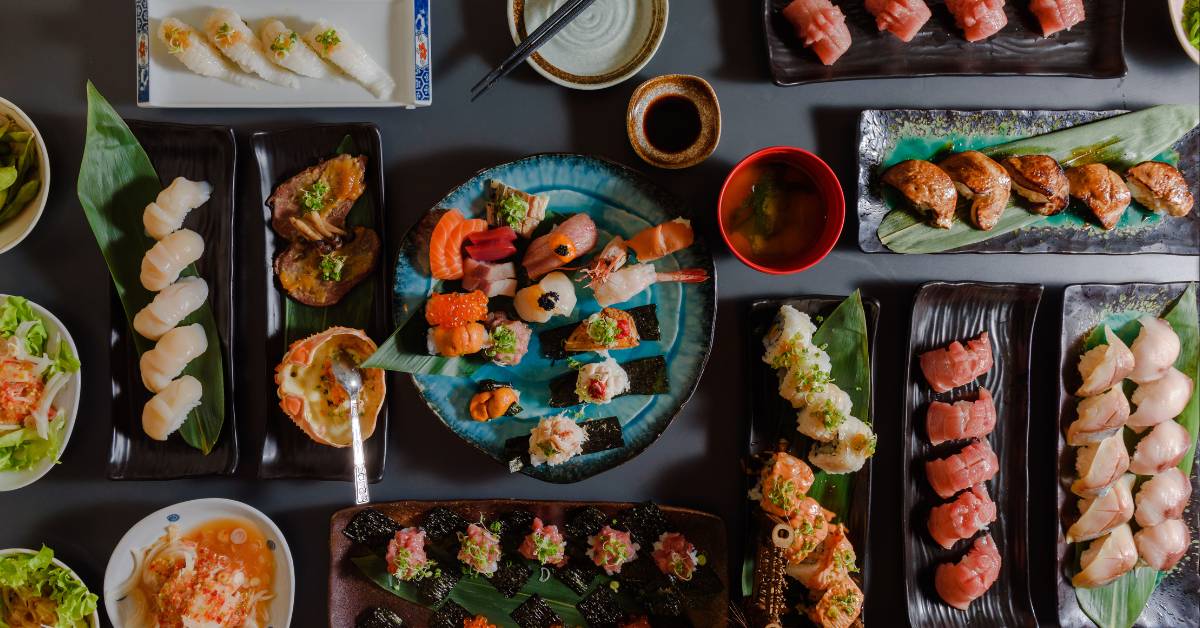Japanese cuisine, also known as washoku (和食), is a famous culinary tradition dating back thousands of years. In Japanese cooking, there’s a commitment to the freshest seasonal ingredients alongside a meticulous dedication to artful presentation – never more evident than in sushi and sashimi, two of the country’s favorite exports.
Here are some staple ingredients used in Japanese cuisine:
- Rice: Rice is a staple food in Japan and is served with almost every meal. It is often steamed and flavored with ingredients like rice vinegar, mirin (sweet rice wine), or dashi (broth).
- Fish and Seafood: Due to Japan’s extensive coastline, fish and seafood play a prominent role in Japanese cuisine.
- Noodles: Noodles, such as soba (buckwheat), udon (thick wheat), and ramen (wheat noodles in broth), are also widely consumed in Japan and come in various styles and flavors.
- Vegetables: Japanese cuisine features a variety of vegetables, both cooked and raw. These are often seasoned with soy sauce, miso (fermented soybean paste), or dashi.
- Soybean: Soybean-based products like tofu, miso, and soy sauce are essential ingredients in Japanese cooking and provide protein and flavor to many dishes.
What are popular Japanese foods?

Japan offers a wide variety of food and there are many specialty dishes to enjoy, all of which are on the Salvaje menu for you to enjoy.
- Noodles: Noodle dishes are a major part of Japanese cooking. At Salvaje, we serve a beef ramen dish with fresh noodles, green onions, fresh corn and a poached egg, as well as a delicious noodle dish with fresh lobster.
- Fried Rice: Fried rice is a classic Japanese staple, and we offer various fried rice dishes, including a wok rice with corn; a wagyu beef fried rice; and the delicious duck fried rice.
- Sushi: One of Japan’s most famous foods, sushi is always served with rice and paired with a protein (usually raw fish). Check out our article on sushi to learn more.
- Sashimi: Unlike sushi, sashimi is never served with rice, and instead features raw fish (or sometimes meat).
- Dumplings: The dumpling is a small, leavened piece of cooked dough wrapped around a protein. At Salvaje, we offer a delicious shrimp dumpling dish.
- Edamam: Edamame is a popular Japanese dish consisting of immature soybeans. It’s instantly recognizable because of the bright green colors on the plate. We serve a steamed edamame dish seasoned with rock salt.
- Tempura: This classic Japanese dish features seasonal seafood and vegetables that are covered in batter and then deep fried for a crispy finish. Our rock shrimp tempura features rock shrimps with wasabi, kale and green onions. deep fried in batter.
- Robata: Robata, or robatayaki, means “fireside cooking”. It’s similar to a barbecue as the food is grilled over coals. Take advantage of our seafood robata and enjoy the smoky flavors on your plate.
All of these items are on the Salvaje menu for you to enjoy.
Where can you find the best Japanese food in Dubai?
Japanese food has come to Dubai in a big way, and at Salvaje, we believe we serve some of the best Japanese cuisine anywhere in the city. Whether you want artfully-prepared sushi and sashimi, noodles, tempura or ramen, our chefs are dedicated to faithfully honoring this time-honored
What makes Japanese cuisine unique?
For one, the flavors are unique. You can expect a delicate pairing of sweet, sour, bitter and salty thanks to ingredients like soy sauce, miso, seaweed and dashi.
Two, Japanese cuisine is distinctly savory in nature. Even typical desserts are often made using red bean paste and mochi, as opposed to simple sugar. This is because Japanese cuisine predates the widespread adoption of sugar, and these recipes have stood the test of time in the process.
Three, and perhaps most importantly, Japanese cuisine has pervaded many other parts of the world. Japanese restaurants can now be found on every continent, and are a mainstay of the Dubai dining scene. Chefs are enamored with the delicate balance of flavors and the exquisite presentation. You don’t simply throw a Japanese dish together: you carefully assemble the disparate ingredients to create a beautiful whole.
